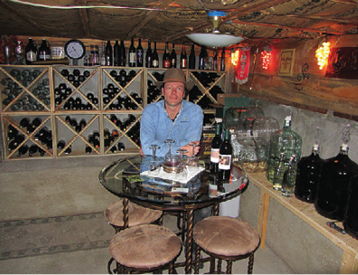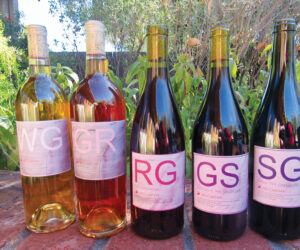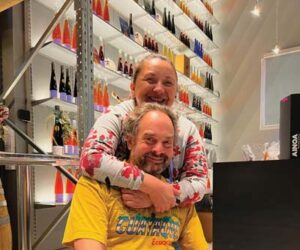It all started with a wedding gift of beer making equipment back in the mid 90s. By the 2000s I wanted to make wine but always thought it would be too hard. After a trip to Sonoma, California in May 2008 I was convinced that making wine was too hard. However, in that following September I took a trip to visit family in Croatia and it all hit me: this is not too hard. I got to spend time with some amazing guys who were making some amazing wine and got to taste it in their cellar in a room next to their chickens and pig. I thought, “If great wine can come out of here, I can do it.”
When I got back home to Colorado I picked up my first wine kit, an Old Vine Zinfandel, and started making wine. At the same time, I was excavating the crawl space in my house to create some extra storage space. I dug approximately 2 feet of dirt out of the 13 x 18-foot space to give me 6 feet of height once the floor was poured. With the help of friends and a 6-bag cement mixer we poured the shelf walls and then the floor. As I stood there trying to figure out how to arrange the shelves, I noticed that the temperature in the space was cool and the humidity was high. I thought, “This would be a pretty cool wine cellar.” And so it was born: the wine cellar to hold my first vintage, a 2008 Old Vine Zinfandel.
I made the diamond racks in 2008 and have since added a shelf for storing wine made from grapes aging in carboys. (Yes, I graduated to grapes this last harvest, but I still make wine from kits, too.) My kids and wife got me the table and stools as a gift and I found some local rough-sawn, beetle-killed pine to dress up the walls. Half of the room is still for storage so I use a portable room divider to hide that side. When the candles are lit and the lights are out the atmosphere in there is wonderful. We’ve hosted many tastings and dinners in the cellar since and our guests always have a great experience.
I am lucky in that the cellar is, for the most part, passive. It maintains a temperature range of 64 °F (18 °C) in the summer and 52 °F (11 °C) in the winter. There was one winter cold snap that prompted me to put a little oil-filled space heater in there to keep the temperature from falling much below 50 °F (10 °C). The humidity runs anywhere from about 40% up to about 60%. Since it is a storage area, I do limit the humidity to a maximum of about 60%. For the Colorado climate, that’s really humid. All the temperature and humidity changes are very gradual as the floor and most of the walls are concrete. The little bit of the cellar that is framed, including the ceiling, are well insulated.
t all started with a wedding gift of beer making equipment back in the mid 90s. By the 2000s I wanted to make wine but always thought it would be too hard. After a trip to Sonoma, California in May 2008 I was convinced that making wine was too hard. However, in that following September, I took a trip to visit family in Croatia and it all hit me: this winemaking stuff is not so hard. During the trip I got to spend time with some amazing guys who were making some amazing wine and got to taste it in their cellar in a room next to their chickens and pig. I thought, “If great wine can come out of here, I can do it.”
When I got back home to Colorado I picked up my first wine kit, an Old Vine Zinfandel, and started making wine. At the same time as when I started my Zinfandel kit, I was excavating the crawl space in my house to create some extra storage space. I dug approximately 2 feet (0.6 m) of dirt out of the 13- x 18-foot (4- x 5.5-m) space to give me 6 feet (1.8 m) of height once the floor was poured. With the help of friends and a 6-bag cement mixer we poured the shelf walls and then the floor. As I stood there trying to figure out how to arrange the shelves, I noticed that the temperature in the space was cool and the humidity was high. I thought, “This would be a pretty cool wine cellar.” And so it was born: the wine cellar to hold my first vintage, a 2008 Old Vine Zinfandel kit wine.
I made the diamond racks in 2008 and have since added a shelf for storing wine made from grapes that is aging in carboys. (Yes, I graduated to grapes this last harvest, but I still make wine from kits, too.) My kids and wife got me the table and stools as a gift and I found some local rough-sawn, beetle-killed pine to dress up the walls. Half of the room is still used for storage so I use a portable room divider to hide that side. When the candles are lit and the lights are out the atmosphere in there is wonderful. We’ve hosted many wine tastings and dinners in the converted cellar since the space was finished, and our guests always seem to have a great experience.
I am lucky in that the cellar temperature is, for the most part, passive. It maintains a temperature range of 64 °F (18 °C) in the summer and 52 °F (11 °C) in the winter. There was one winter cold snap that prompted me to put a little oil-filled space heater down there to keep the temperature from falling much below 50 °F (10 °C). The humidity runs anywhere from about 40% up to about 60%. Since it is a storage area, I do limit the humidity to a maximum of about 60%. For the Colorado climate, that’s really pretty humid. All the temperature and humidity changes are very gradual as the floor and most of the walls are concrete.
The little bit of the cellar that is framed, including the ceiling, are well insulated — perfect for storing my homemade wine!









